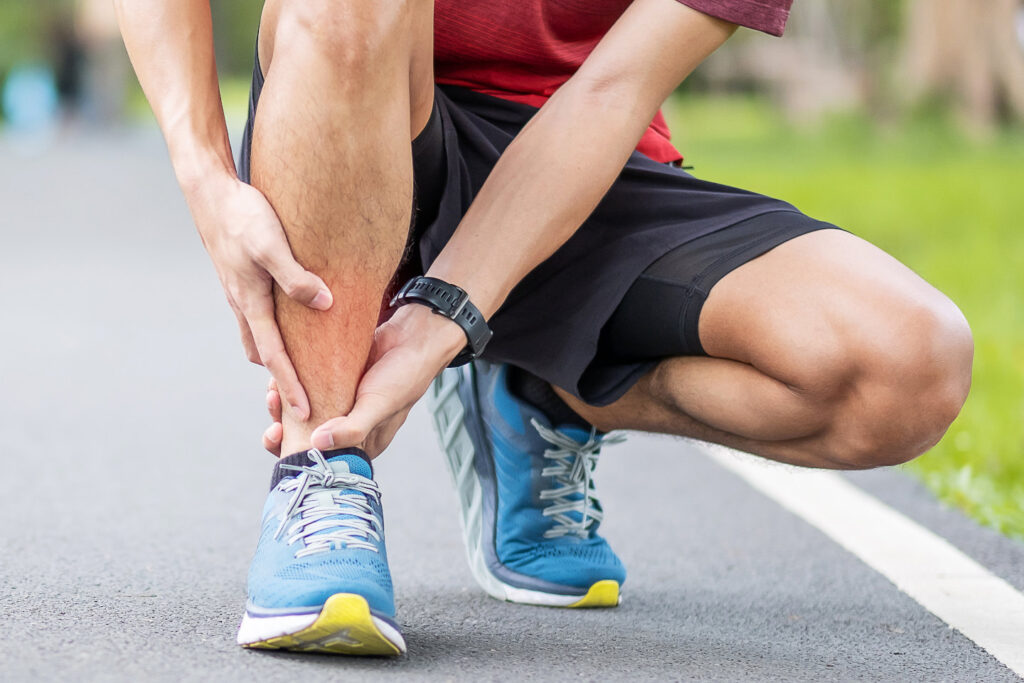Tackling Shin Splints Head-On: Managing Your Shin Pain

A Guide to Preventing Shin Pain After Physical Activity
If you have ever dealt with the pesky pain in your lower legs keeping you from normal activity, you know that it can be persistent and difficult to shake. You may be dealing with shin splints. Here are some things that will help with managing your shin pain and offer some relief to stay ahead of the troublesome pain.
What Are Shin Splints?
Shin splints, also known as medial tibial stress syndrome is recurring pain caused by inflammation of muscles, tendons, and bones that surround the shin. Although shin splints are not a serious injury, it can prevent individuals from weight-bearing activities. Often, shin splints arise following a more dramatic and abrupt increase in activity. An over-ambitious rise in intensity and amount of activity can sometimes be too much for the muscles to handle.
You may have two major pain patterns of what are considered shin splints:

- Inside (Medial) of your shin? Caused most commonly by the soleus or the tibialis posterior muscles, located in the rear portion and the inside of your shin respectively.
- Front (Anterior) of your Shin? Caused by the tibialis anterior muscle, located in the front portion of the lower leg.
In early stages, individuals report pain at the onset and ending of physical activity, with a decrease in pain throughout the activity. The decrease in pain may soon progress to be sharper and more prolonged. Addressing the pain early can greatly help in managing the shin pain. If this still leaves you uncertain, the physiotherapists at SOS Physiotherapy are a great option for a conversation about your pain as well. Speaking with a physiotherapist offers the best option for a structured recovery.
Differential Diagnoses
There are other underlying conditions that your shin pain may be classified as. These conditions hold different grounds of recovery and management. For this reason, it is best to consult your physiotherapist with your pain to ensure you are getting the proper treatment.
Stress Fracture:
Stress fractures are hairline cracks in the bone that occur from long periods of repetitive loads put on the bone. When they do occur, they are common in the lower leg. You may experience a dull pain that progressively gets worse with activity, similar to the progression of shin splints. The best option is to consult your physiotherapist or chiropractor about your pain for ruling stress fractures out.
Compartment Syndrome:

Compartment syndrome is a condition in which groups of muscles surrounded by fascia, or stronger connective tissue, experience bleeding or swelling. Fascia is not as elastic as your muscles are. This can cause elevated levels of compression, limiting blood flow to the areas that are further away from your heart, like your feet. You may be able to locate high levels of bruising, the feeling of pressure in your leg, or even shiny skin. The area of the body this occurs will also be painful.
Compartment syndrome can occur from large repeated blows to certain areas of the body. Acute compartment syndrome is a medical emergency and action should be taken immediately to prevent permanent debilitations. In chronic cases, the major cause may be repetitive motions during exercise or work. Chronic compartment syndrome is NOT a medical emergency and symptoms may cease with activity. Consult your physiotherapist if you suspect this may be a possibility.
What Am I Doing to Cause My Pain?
Like anything, there is most often not just a single aggravating factor of the lower leg muscles causing you pain. The causes are multifaceted, each holding their own role in causing muscular sensitivity. Here are some of the most common sources of your pain:
- Footwear: speaking with your physiotherapist, chiropractor, or pedorthist about optimal footwear can help with shock absorption. Shoes that absorb shock well are able to reduce the wear and tear on your muscles and bones during activities like walking or running. In the Kitchener-Waterloo area, we recommend Kimberly Rau and Associates Inc. for all things footwear!
- Activity level increase: A dramatic or abrupt increase in activity can cause inflammation. It is best to slowly introduce your muscles to higher levels and intensities of exercise.
- Terrain or landscape: Sloped landscape, very hard surfaces, uneven, or irregular surfaces are harder on the muscles that aid in walking or running. Putting more stress on the muscles can be tiring over longer periods of time.
- Intrinsic factors: You may have heard of the famous phrase “use it or lose it”. When muscles are not used as much as others, they become weak and susceptible to inflammation. Conversely, when the muscles become too tight, you may experience deficits in range of motion, another contributor to your pain.
Recovery and Management for Your Shin Pain
Generally, shin splints do not become bad enough to warrant invasive treatment techniques like surgery. What is deemed most effective in the long run, is strengthening exercises and stretching along with other pain management techniques.
Short term care treatments:
Acute treatments can be a good mediator of pain when it is the strongest. Here are some of the treatments we offer at SOS Physiotherapy for managing your shin pain:

What you see here are great options for increasing blood flow, bringing nutrients in and waste out! This helps to reduce inflammation and induce a healing effect on the damaged tissues. Along with this, most of these options will acutely reduce the physical tension of the muscles, offering some short term relief.
Long term solutions:
Relative Rest: Perhaps the most important approach for managing your shin pain is rest. Relative rest is essentially resting until symptoms stop, followed by engagement in physical activity at a much lower intensity and volume. This prevents resurgence of pesky pain symptoms. Strengthening the muscles at a level that does not reintroduce pain strengthens the muscles, all while preventing regression in progress. This approach allows the muscles to remain healthy throughout growth and recovery.
Stretches and Exercises: as previously mentioned, stretches help with range of motion and muscle tightness. When muscles are too tight they become much easier to inflame or strain. Exercises strengthen the muscles. This allows them to do more work without becoming tired. Training the muscles for more activity will make activity recovery much smoother, or even unnoticeable with consistency.
Exercises and Stretches for Shin Splints
Although these treatments manage your shin pain in acute time frames, it is exercise and stretching that will resolve them and keep them out! You may have heard the saying “Motion is lotion”, and for the most part, this is true. With a slow ramping of activity (intensity and volume), the muscles become stronger progressively. As you remain strengthening and stretching the muscles with activity, the risk of recurring shin splints can virtually dissolve! Here are some exercises and stretches that our physiotherapists recommend:
Stretches:
Exercises:
FAQs
What will stop my pain the quickest? Well, although remedies like laser therapy, ultrasound, or heat and ice therapy will offer relief, the best medicine for a stress injury like this is REST!
Are there things I should change in my exercise routine to prevent shin pain? Any good exercise involves a thorough warmup. Engaging in stretches and muscle activation exercises is the best way to prepare your muscles for exercise. Along with this, strengthening exercises are important to stick to on off-days to maintain strength. Motion is lotion! And remember — when increasing the amount of exercise you are doing, do it slowly!
What makes the different kinds of shin splints different? To put simply the world of shin splints is vast and it is just the muscles that are irritated that make this condition different from case to case. Your physiotherapist may go through different physical examinations in order to find the culprit. Seeing one of our physiotherapists at SOS Physiotherapy is a great option for a professional opinion!

